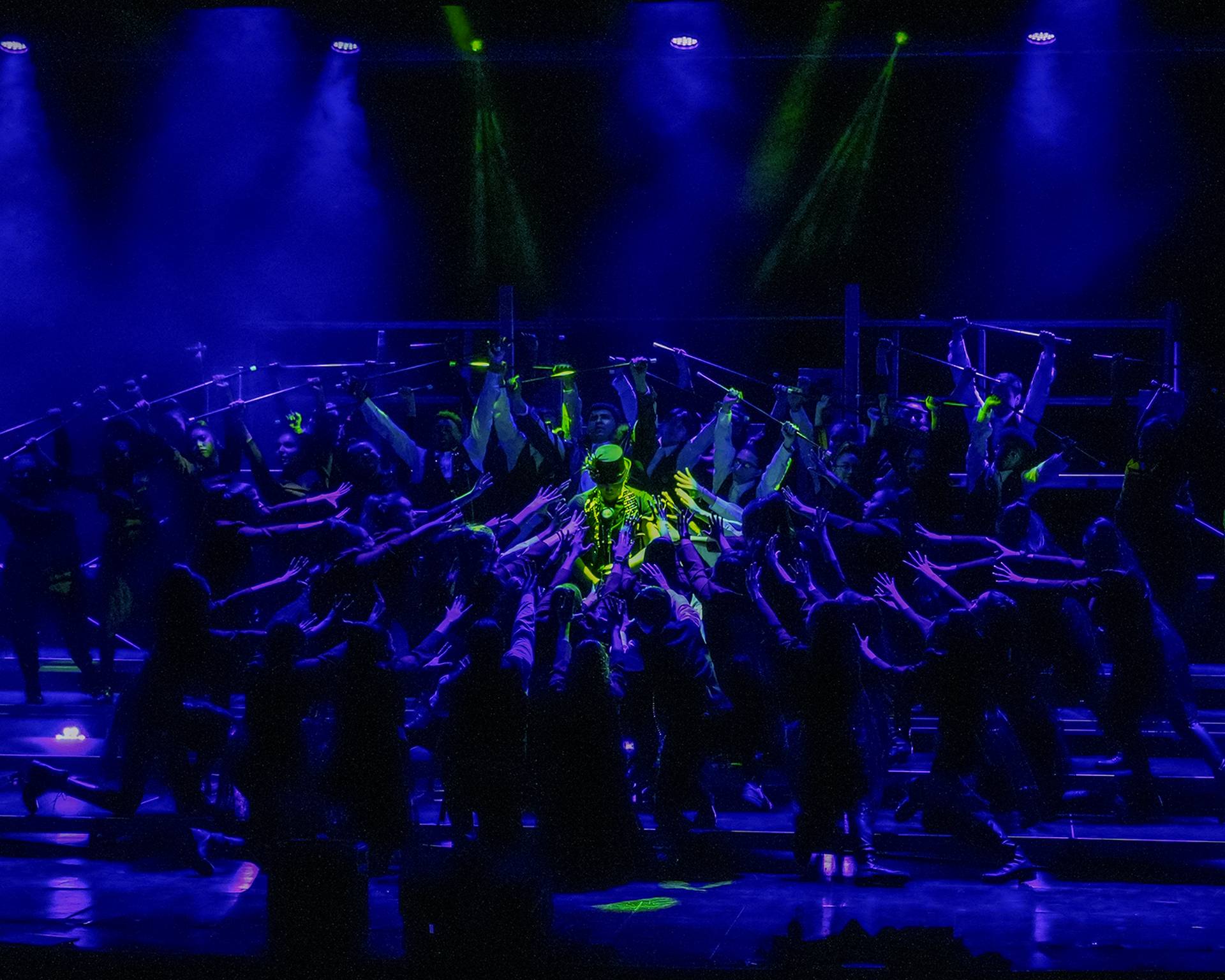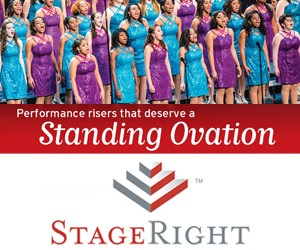
Today, the city’s chamber of commerce boasts “To know our city is to love it—rich history, beautiful architecture, the sights and sounds of industry—trains, barges, and our trademark bridges, abundant wildlife, fantastic parks, a thriving arts community… and so much more.”
Show choir is one of the arts offered at Dwight D. Eisenhower High School in Blue Island. Tina Jacklin has been directing the choirs at Eisenhower and competing with the show choir for twenty years.
Intrigued by their undefeated 2021-2022 season and an unexpected choice to not compete during the 2022-2023 season, I talked with Tina about her program.
■ Thank you so much for meeting with me! First of all, talk a bit about the show choir program at Eisenhower and in your district.
Thanks for inviting me! Our show choir has been all over the board. We’ve been in small division, then we were a large division for a long time. We’ve had some pretty competitive years, not always one or two but in the finals. We had a pretty good run, then when covid hit, it came to a screeching halt, like many programs. We went from 180 or 190 in the program pretty consistently before covid down to 130 now. We are trying to build that back.
One thing that is unfortunate where we are is there are no show choirs at the middle-school level. Some of the middle schools don’t have a choir program at all. Covid really broke that pipeline. Our middle schools were late to having music programs brought back. Within the last two years, a lot of them just didn’t have enough kids to have choir.
■ You did have an undefeated season in 2021-2022. That is quite an accomplishment considering the school year that was 2020-2021 and the fact that some of the middle schools don’t have choir at all.
When we came back from covid I had a pretty good core of kids who still wanted to do show choir and compete and a ton of kids who had no idea what this was. Again, they didn’t have it in middle school, and we weren’t able to perform for them in middle school like we usually did. So it felt brand new to everybody besides that small core group of seniors and some juniors. We went in the small division and worked really hard. We had to be masked at every competition and it was a really tough year but I was very happy. It was huge for our school.
■ You chose not to compete in the 2022-2023 season. What performance opportunity did you offer for the students?
I did something totally different that we had never done before. I took sixty-two kids and we did a stage show that I constructed with my assistant, Victor Rodriquez. It was called Enemy and we based it on the musical Six with villains. I had some sets behind us, some dialogue in between songs. We had game show hosts introduce the three different villains. The villains gave their backstory in the songs, then we had group numbers. We asked “Who’s the baddest villain of them all?” At the end the audience voted and we crowned the winner then went into the closer. It changed the trajectory of the closer depending on the vote.
It was longer than the usual show, almost twenty-six minutes versus eighteen. A lot of kids were involved. The competition aspect was taken out, but they did learn how to do show choir. I wanted them to experience that without the scariness and pressure of competing.
■ Was it original music or pieces you pulled together?
Mostly pieces we pulled together. Dan Scoville arranged it for us and he did put in some original music where needed for transitions. We used music from various genres that had to be sewn together with a common theme. He has a really good creative vision for weaving all that together.
Samual Mulligan was our choreographer. He was so helpful from the beginning. The choreography for something like this couldn’t just be stand alone numbers. Every villain had a highlight in the closer so some of their choreography was brought back. Samual was amazing!
■ I think that’s really interesting to come back from covid, have a winning season, then choose to do something fresh instead of trying to repeat that success.
We could have maybe had the same kind of season. I don’t know how enjoyable that process would have been for the kids I had. The ones who had no experience vastly outnumbered the few who had competed. This is supposed to be about creative arts and having a good time in the process. What do they love about show choir? They love to perform, they love characters, they love dancing. It takes a minute to get that kind of dance in your body and a lot of them come to me with no singing experience. I wanted to capitalize on bringing some of the joy and getting the energy of show choir out there, because I feel like that’s really what it’s all about. Creating the show, making the connection with the audience and with one other. That was my number one focus, so how could I do that effectively? That’s where it came from.
It was a bit more of a forgiving environment for them to take chances. I think I needed the reset also. It had a positive effect on our musical that year. It had an effect in the classroom. I simply tried to give them some confidence to try new things. At the moment for us, it was what we needed.
■ How did the students respond?
The good thing is, it was very successful. They had fun. I had a meeting with them in the spring and asked if they would like to go back to competing in the 2023-2024 season or do another show with audience participation. I was really game for either. They said they were ready to compete and the older kids, the few that were left from a competitive group, were all about that.
We will be competing this year. I have forty-eight kids and two crew members, and they are really excited. We are doing a show where the kids represent two different beings and gender doesn’t matter.
■ I’ve noticed a trend of putting together shows and costume pieces not based on gender. Tuxedos and dresses have their place depending on what it is you are doing. I like the shift away from that. It gives more options for expression.
I like it all ways—there’s a place for all of it. Our show this year is based on the AI (artificial intelligence) presence and the human presence and how it all inter- works. Are you the AI representing or the human aspect of the show? It keeps changing and morphing through the show. I think it gives choreographers more freedom, too. I like the flexibility and I think the students do too.
■ Have you noticed a difference in the cohorts of students over the past 20 years?
We’ve always had a nice strong pocket that supports the arts. My district is supportive of the arts. There is a good twenty percent of the student population that does it all. I do feel they are more stressed because the expectation keeps rising. There has been a push recently for more AP classes. My group this year is hard working with a great attitude. There’s pure joy when they walk in. It did not feel like that a year or two ago. It was much more solemn, much quieter, more easily overwhelmed. Show choir is not something you take lightly. If you are going to compete it’s a whole different ball game than just going somewhere and doing a dance and singing, and I think a lot of people misunderstand that. It’s a different mindset, a different work ethic, all of that. We work with some of the most outgoing, well-organized students in the school. That’s why I love the arts.











